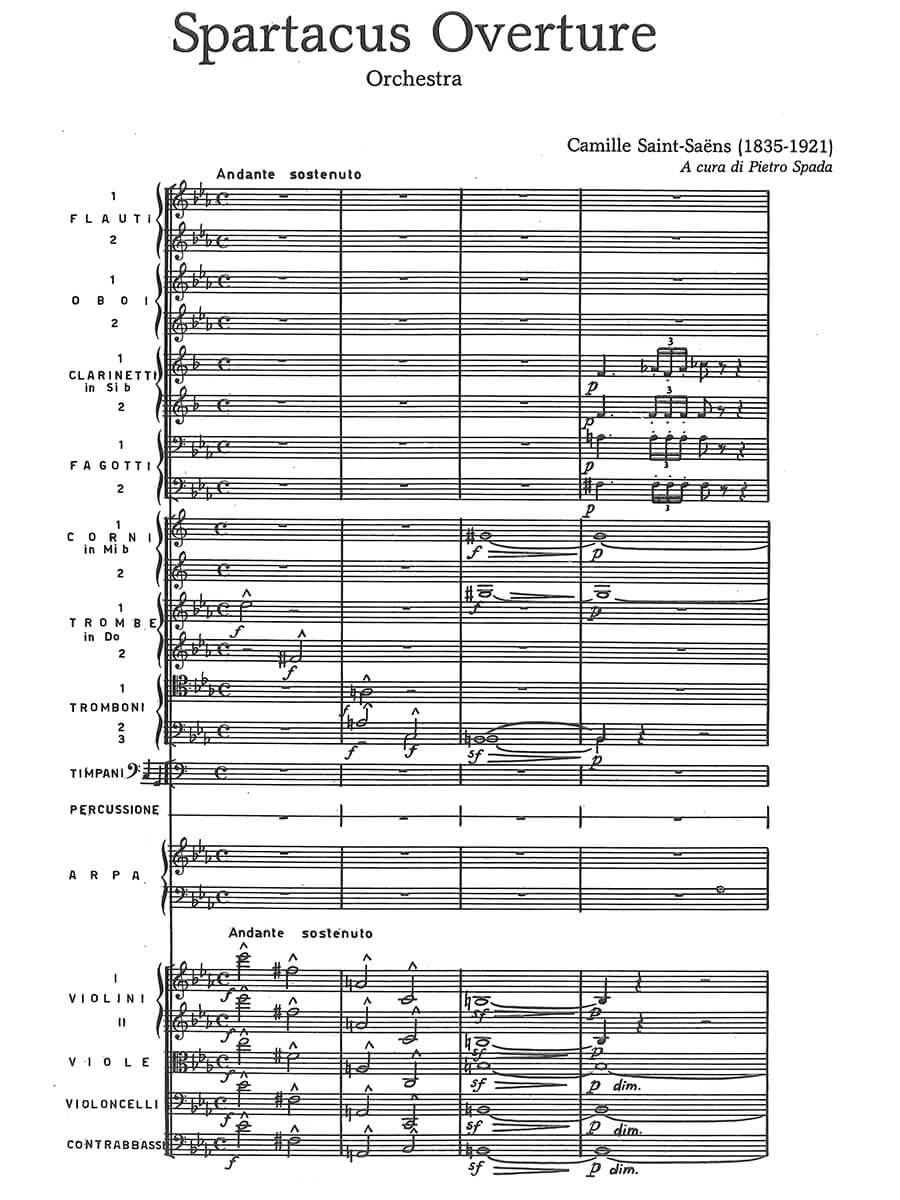Spartacus, Concert overture
Saint-Saëns, Camille
31,00 €
Charles-Camille Saint-Saëns
(b. Paris, 9 October 1835 – d. Algiers, 16 December 1921)
Spartacus
Concert Overture
Preface
Born in 1835, Camille Saint-Saëns was raised by his mother and great aunt after his father’s death that same year. His precociousness in music and general studies was evident early on. His musical debut at the age of ten, performing Beethoven and Mozart piano concertos from memory, evidences an early life as a prodigy. Outside of his musical studies, he pursued interests in many other areas including astronomy, philosophy and science.
Aesthetically, Saint-Saëns was a paradox. He was a champion of French music, especially music of the earlier masters Gluck, Rameau, Grétry, but among his earliest influences were the progressive Germans, especially Schumann, Schubert, and Liszt. His musical eclecticism blended the futuristic elements of Liszt and Wagner with the refinement of music from the Baroque and Classical periods. Combining these influences, he developed a compositional style that blended classicism with adroit forms and structures, and pioneering melodic and harmonic content. In his middle life Saint-Saëns refuted Wagnerism, while in late life he condemned the emerging styles of the twentieth century, most notably the works of Stravinsky and Schoenberg. By the time of his death in 1921, he had become marginalized by a younger generation of composers for his conservative.
Saint-Saëns’s first, and most influential, teacher of composition was Pierre Maleden. Upon entering the Paris Conservatoire in 1848, he joined the organ class of François Benoist, gaining the first prize in 1851. That same year he commenced composition studies with Halévy, but was unsuccessful in his quest for the Prix de Rome in 1852.
Among his closest professional relationships was with Franz Liszt. Saint-Saëns first met Liszt in October of 1853 at the home of Francois Seghers, a Belgian violinist and organizer of a concert series of the Société de Sainte-Cécile. Saint-Saëns had just completed his first symphony and was recently appointed organist at the parish church of Saint Merry. From that point onward, the two maintained a close relationship. Liszt was influential on the younger Frenchman, and Saint-Saëns remained a champion of Liszt’s music throughout his life, arranging concerts of Liszt’s works in Paris, promoting and performing the music of the older composer, often stretching the limits of accepted musical norms. Liszt arranged for performances of Saint-Saens’s works, most notably his opera, Samson et Delilah, a work that Saint-Saëns could not get staged in Paris.
In 1852, Saint-Saëns’s Ode de Sainte-Cécile won first prize at the competition of the Société de Sainte-Cécile in Bordeaux. In 1857, his symphony Urbs Roma, obtained another first prize at the competition. Interestingly, his close friend Georges Bizet completed a similarly titled symphony around this time. From 1861 to 1865 he was a piano teacher at the Niedermeyer School where he had Gabriel Fauré, André Messager and Eugéne Gigout as pupils. The concert overture Spartacus won the 1863 competition organized by the Société Sainte-Cécile of Bordeux, winning unanimous praise from the judges. However, his second attempt at the Prix de Rome that same year resulted in another failure. Ironically, the conservatory judges felt that he had too much experience as a composer.
Spartacus is an early example of Saint-Saëns innovative use of form and thematic transformation, traits he likely gleaned from the works of Franz Liszt. The overture also represents Saint-Saens fondness for subjects from classical antiquity as evidenced by an 1867 work for a competition the cantata Les Noces de Prométhée, and his Scène d’Horace of 1861. The Spartacus Overture may have been the start of an opera, but if so it was never taken up. As a work unto itself, the overture merits study as an early forerunner of the symphonic poem and as a fine work. While Spartacus was not the earliest example of thematic transformation, it is Saint-Saëns’s first attempt at it and, perhaps, the earliest example from a French composer. It was also a prelude to his later symphonic poems that would begin with La Rouet d’ Omphale from 1871. The symphonic poem became an outgrowth of the opera overture, taking literary subjects for inspiration. …
Read full preface > HERE
| Score No. | 3027 |
|---|---|
| Edition | Repertoire Explorer |
| Genre | Orchestra |
| Size | |
| Printing | Reprint |
| Pages | 128 |
